Industry
Korean Submarine Capable of Carrying Cruise Missiles Offered to Poland
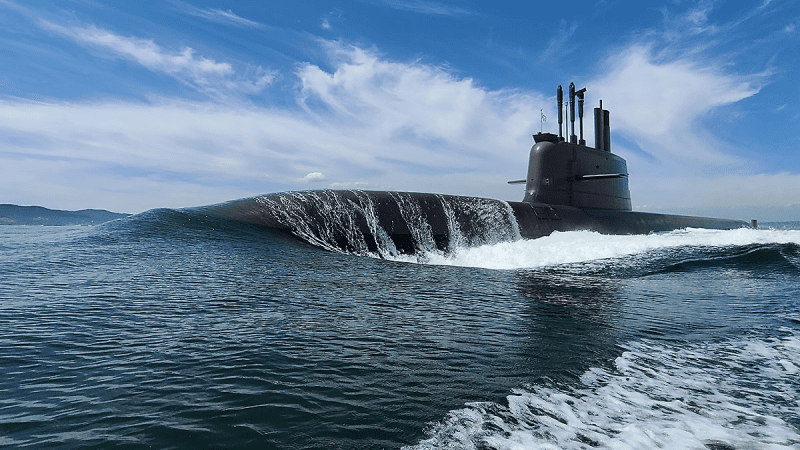
Photo. Hanwha Ocean
South Korean Hanwha Ocean company is offering its KSS-III proprietary submarine design for the Polish Navy, within the framework of the „Orka” procurement programme. This vessel’s main features, distinguishing it from the competing design include the integration of armament, such as a VLS system for cruise missiles, and propulsion including an AIP solution underwater, and Li-Ion batteries.
The conference held in Warsaw on 29th November 2023 was to get the Polish journalists acquainted with the capacity offered by the South Korean Hanwha Ocean company (part of the Hanwha Business Group), with a particular emphasis placed on its submarines-building capabilities. The Koreans, for a couple of months now, have been declaring their willingness to participate in the „Orka” programme, by offering their KSS-III submarine design for the Polish Navy.
Hanwha Ocean’s specialists claim that not only could Poland obtain the capability to carry out standard submarine operations, but also the capacity to establish an underwater deterrence system. This is possible thanks to the cruise missiles, carried by the offered vessels. According to the Koreans, that would undoubtedly boost the levels of security in the Baltic region.
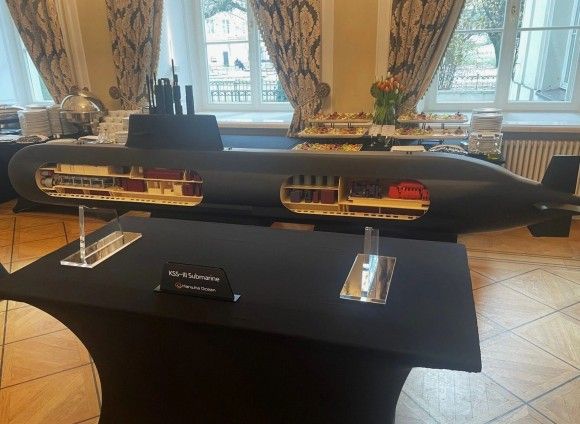
Hanwha Ocean already has a major experience gathered in the area of building submarines. These capabilities have been established jointly with the German TKMS company, since 1983. In the beginning, the company was building the small KSS-I Yang Bogo-class submarines (license-manufactured German Type 209), with underwater displacement of 1,400 tonnes. So far, a dozen have been built (9 for South Korea, and three for Indonesia).
Later on, also with German assistance, a series of nine KSS-III Sohn Wonyil class submarines were built - with a displacement of 1,830 tonnes when submersed (license-manufactured Type 214). The expertise and know-how gathered across those two programmes allowed the Koreans to develop designs of their own, for their own Navy. In that way, the KSS-III Dosan Ahn Changho class was born. Two vessels as such are in service already, while one is undergoing sea trials.
These submarines have also been offered to Poland. KSS-III submarines were built during a programme launched in 2004, that began from a conceptual stage. In 2008 a baseline design was created, and work also began, in parallel, on Li-Ion batteries, VLS system, CIC, and other elements of the vessel. The first KSS-III submarine was commissioned in 2021, and the second one in 2023. The last, fifth vessel would be commissioned in 2028.
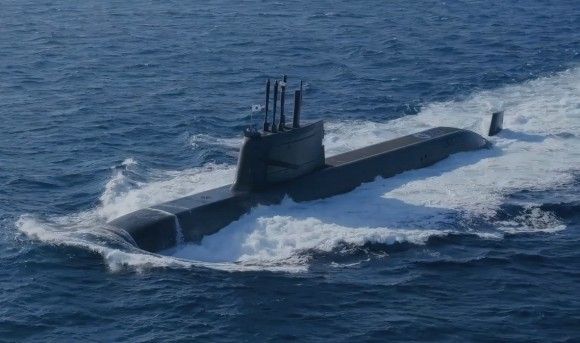
Photo. South Korean MoD
KSS-IIIs are relatively large, for submarines. They have a displacement of 3,600 tonnes, and are 90 meters long. The Koreans claim, however, that they would be capable of easily operating in the Baltic Sea. The representatives of the Korean company noted that the Korean Peninsula is surrounded by the Yellow Sea in the West, the average depth of which is not bigger than the one of the Baltic Sea (42 m vs 54 m). That does not mean that Chinese, North Korean, or South Korean submarines do not conduct operations there.
The KSS-III submarines offered to Poland have three, important advantages. The first one is the underwater propulsion system that includes a fuel-cell AIP system, and advanced Li-Ion batteries. The Koreans state that they have set a new standard for conventional submarines, by deploying this system. That combination allows the vessel to operate without surfacing for more than three weeks.
Not only do the Li-Ion batteries offer longer operating times, they are also cheaper to operate. For standard acid-lead batteries, the lifetime is defined as around 2,000 charging cycles, and for Li-Ion batteries that number can be doubled. The introduction of a solution as such has not been easy. For Pb-Acid batteries the submarine electrical grid is operated at 250 V. For Li-Ion batteries, we are dealing with a voltage of 700 V.
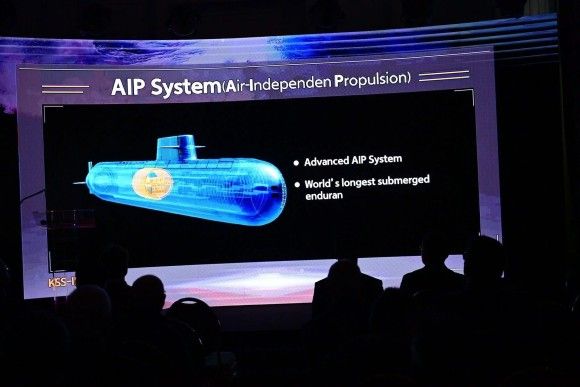
The advanced weapons system is another advantage of the KSS-III vessel. Apart from torpedoes and mines, standard for submarines, the Koreans also integrated ballistic and cruise missile launch systems on these boats. They are launched with the use of VLS, not so common on submarines of this class. Presenting movie clips recorded during tests, the Koreans have proven that the solution has achieved operational readiness.
The diminished acoustic signature is the third feature that distinguishes the KSS-III vessels from other designs. This has been achieved through optimization of the hull design, the use of non-cavitating propellers, and proper fitting of the internal equipment, all contributing to lowered noise emissions. The noise may also be controlled by the vessel’s sonars (8 in total, including side-looking sonar, and linear towed sonar array).
The Koreans do realize that they are not a NATO member state, however, visiting Warsaw they were stressing the fact that they have already proven their capability to work with the allies, including the United States (during the PASSEX exercise for instance), Japan, Australia, and Singapore. That cooperation is not just limited to actual operational activities, but it also involves preparation for conducting joint submarine rescue operations. In this area, also thanks to the support provided by Germany, the South Korean submarine designs are NATO compliant.
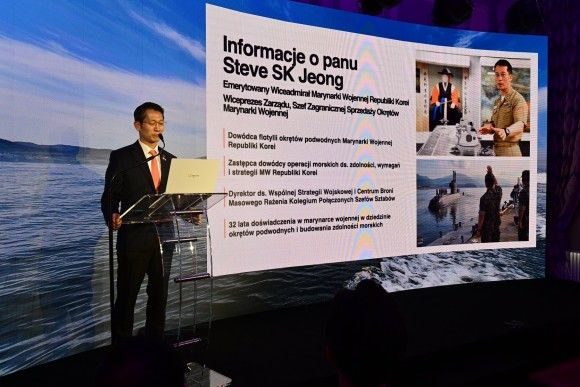
Most importantly, not only does the Korean offer for Poland include the delivery of modern submarines, but also envisages crew training. That training is to be a four-staged process, and it is to include a basic course on submarine operations, a course on equipment handling, tactical simulator training, and sea training, onboard the actual vessel. No language barrier would occur, since it is a standard onboard South Korean vessels to use the English language. The South Korean Navy also declared that it would offer support during sea trials, and training in maintenance, and also share the know-how with the Polish Navy.
That does not mean the Polish Navy would not maintain self-sufficiency in using the submarines. They would be built in South Korea, but Hanwha Ocean plans to establish an MRO facility in Poland. The Koreans claim that not only would that facility render support, thanks to the team on-site, but it would also ensure timely delivery of spares and manage the process of preventing the submarine from becoming outdated, and also gather broad know-how, allowing Poland to autonomously and effectively maintain the fleet of submarines.
The MRO is not the only investment Hanwha Ocean is proposing for the Polish industry. The Koreans do talk seriously about the establishment of a strong industrial partnership that would bring major economic and industrial benefits to Poland. One should remember that this is one of the largest shipbuilding companies in the world that, ever since it was founded in 1973, using its Geoye island shipyard in the Gyeongsang province, has delivered more than 1,256 civilian ships, and 108 offshore systems (including drilling platforms), and 88 warships (destroyers and submarines included).
We are ready to offer the KSS-III Submarine to Poland, one of the best submarines in the world, within the framework of the Polish Orka programme. Using that occasion, we also want to share our long-term vision of partnership with Poland.
SUNG KYUN YEONG - Vice-President and Head of Shipbuilding for International Business at Hanwha Ocean
The cooperation with Poland may cover all of those areas, and also activities tied to broadly understood protection of the natural environment. Hanwha Ocean is deeply engaged in work aimed at limiting the propulsion emissions, and also in the area of renewables (solar and wind). The Koreans would also like to work together with Polish institutes and universities in that area.
